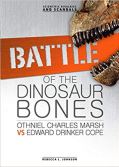
This month on STEM Tuesday, we’re celebrating all things dinosaur—from fossils to their biology to the scientists who study (and sometimes fight over) them. Here are a few activities to try in the classroom to go along with this great selection of books.
Dinosaur bones: And What They Tell Us, by Rob Colson\
Opening this book is like opening a field sketchbook. It’s filled with watercolor drawings, complete with labels and descriptive notes. Annotated skeleton sketches allow readers to compare their own bones to those of dinosaurs and other prehistoric animals. A fun way to browse dino facts.
-
-
-
- Use clay to model some miniature dinosaur bones. Have students find a bone from a skeleton sketch in the book and then create their model from the drawing.
- How do skeletons tell us what dinosaurs really looked like? Artists use the skeletons to build bodies in illustrations. First they add a body shape over the skeleton, then they shade the drawing, and finally they add details, like feathers and eyes. Provide students withe fossil drawings and ask them to build out their bodies in illustrations.
-
-
Dining with Dinosaurs: A Tasty Guide to Mesozoic Munching, by Hannah Bonner
If you are starving for dinosaur knowledge, this book serves up a full-course meal of mouthwatering Mesozoic food facts. Starting with who ate who. Along the way, we meet scientists who explain tough questions about dinosaur poop, teeth, and more.
-
-
-
- Have students pick some dinosaurs from the book and create food chains for them along with illustrations.
- Ask students to pick a dinosaur and then draw a dinner plate filled with that dinosaur’s favorite foods, with labels.
- Have students imagine what future scientists might guess about their diets by looking at their poop, teeth, and other fossils. Ask them to write a short description of the scientist’s findings.
-
-
 Gutsy Girls Go for Science: Paleontologists, by Karen Bush Gibson; illus. by Hui Li
Gutsy Girls Go for Science: Paleontologists, by Karen Bush Gibson; illus. by Hui Li
The first chapter introduces the science of paleontology, along with tips for how to pack your field kit. Then we examine the work and challenges of scientists Mary Anning, Mignon Talbot, Tilly Edinger, Zofia Kielan-Jaworowska, and Mary Leakey. There are plenty of “Field Assignments” (hands-on STEM projects) ranging from modeling an excavation to finding clues in teeth, and informative sidebars are sprinkled through the chapters.
-
-
- Students can pick a female scientists to research more. Have them write a mini-comic book biography of the scientist, showing some important moments in their lives and research.
- Discuss with students why the author chose the paleontologists that she did. What does each paleontologist bring to the book? How is their research different?
- Try one of the many STEM projects in the book!
-
 Tooth & Claw: The Dinosaur Wars, by Deborah Noyes.
Tooth & Claw: The Dinosaur Wars, by Deborah Noyes.
This is a tale of the epic rivalry that exploded into a personal – and professional – war between two early fossil hunters. Edward Drinker Cope wanted to find the biggest, best bones of the newly discovered dinosaurs. So did Othniel Charles Marsh. Their race to uncover bones played out across the American West and they discovered dozens of dinosaur species. But their animosity ruined their lives. Includes a list of museums where modern dino-hunters can find bones.
-
-
-
- Create compare and contrast charts with the contributions of both Othniel Charles Marsh and Edward Drinker Cope to the field of paleontology.
- Have students imagine an alternate world where people did not believe that dinosaurs once existed on Earth. They should think about what might have happened if these two scientists could not have convinced the public that dinosaurs did exist. Have students write a short story about this imagined reality.
-
-
STEM Tuesday classroom ideas prepared by:
 Karen Latchana Kenney especially enjoys creating books about nature, biodiversity, conservation, and groundbreaking scientific discoveries—but also writes about civil rights, astronomy, historical moments, and many other topics. Her award-winning and star-reviewed books have been named a YALSA Quick Pick for Reluctant Readers, a 2015 Book of Note from the TriState Review Committee, a 2011 Editor’s Choice for School Library Connection, and Junior Library Guild selections. https://latchanakenney.wordpress.com
Karen Latchana Kenney especially enjoys creating books about nature, biodiversity, conservation, and groundbreaking scientific discoveries—but also writes about civil rights, astronomy, historical moments, and many other topics. Her award-winning and star-reviewed books have been named a YALSA Quick Pick for Reluctant Readers, a 2015 Book of Note from the TriState Review Committee, a 2011 Editor’s Choice for School Library Connection, and Junior Library Guild selections. https://latchanakenney.wordpress.com

















 Maria is a children’s author, blogger, and poet passionate about making nature and reading fun for children. She’s been a judge for the Cybils Awards from 2017 to present. And a judge for the #50PreciousWords competition since its inception. Her poems are published in The Best Of Today’s Little Ditty 2017-2018, 2016, and 2014-2015 anthologies. When not writing, critiquing, or reading, she bird watches, travels the world, bakes, and hikes. Visit her at
Maria is a children’s author, blogger, and poet passionate about making nature and reading fun for children. She’s been a judge for the Cybils Awards from 2017 to present. And a judge for the #50PreciousWords competition since its inception. Her poems are published in The Best Of Today’s Little Ditty 2017-2018, 2016, and 2014-2015 anthologies. When not writing, critiquing, or reading, she bird watches, travels the world, bakes, and hikes. Visit her at